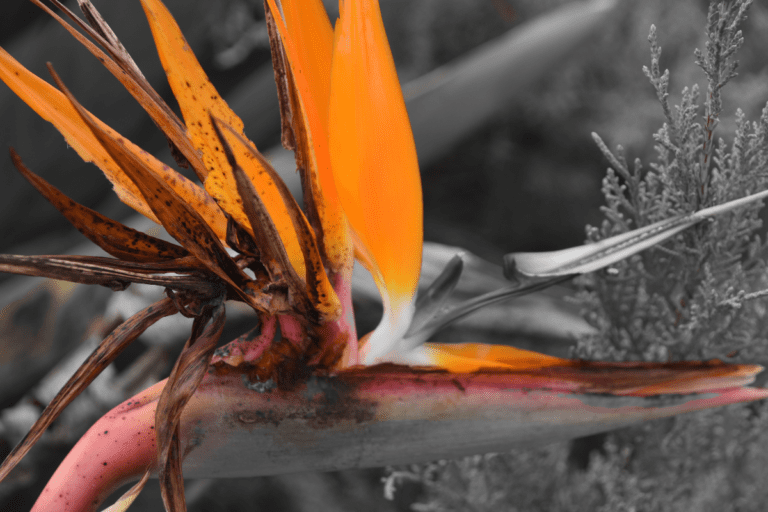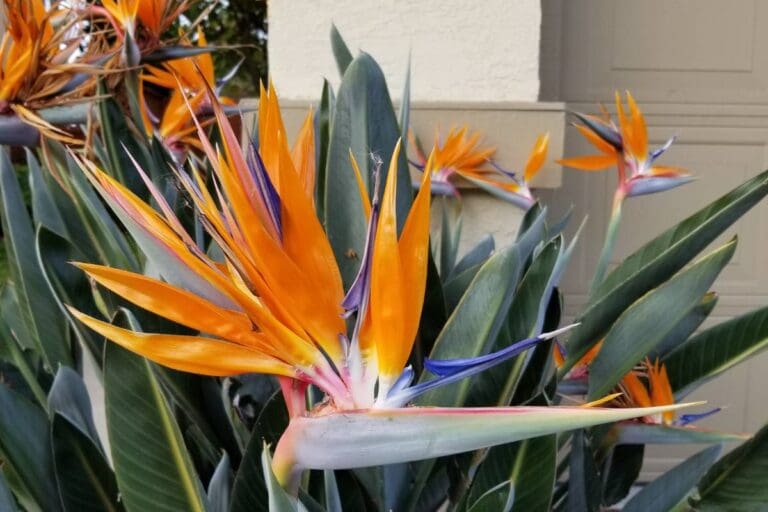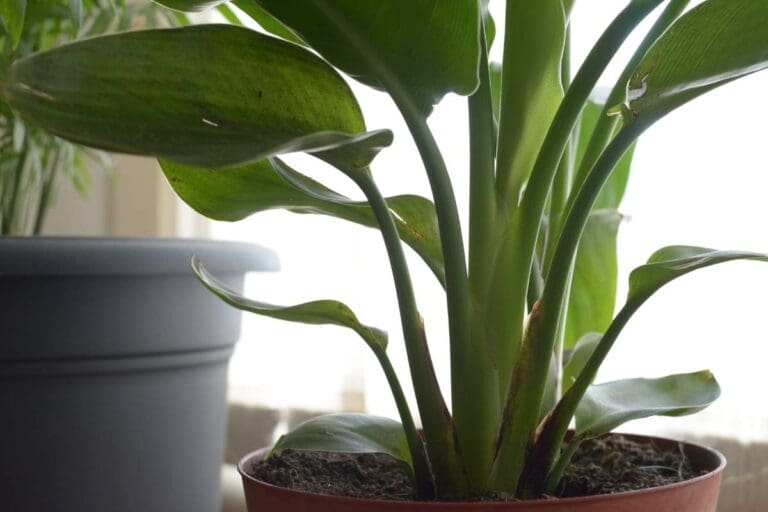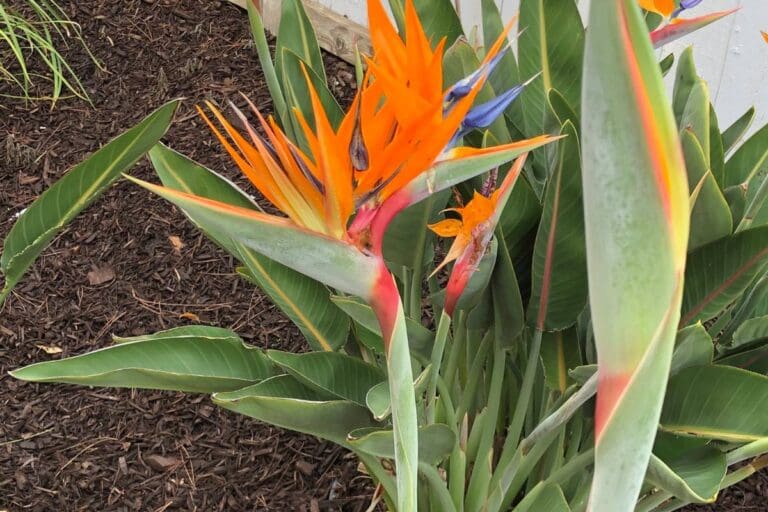When Should I Repot My Birds Of Paradise?
A common mistake people like me make is forgetting to repot our indoor plants. Bird of Paradise is a beautiful tropical plant that requires repotting from time to time to maintain its huge and gorgeous foliage.
Bird of paradise requires repotting every 1.5-2 years during spring. However, if your plant is doing well, you can wait over 2 years to repot it. A slightly root-bound condition helps the bird of paradise bloom but remember to repot it if the plant is extremely root-bound.
This article will help you understand everything related to repotting a bird of paradise. So, keep reading.

Please note: Simplify Plants is reader-supported. Some links in the post are affiliate links and I get a commission from purchases made through links in the post.
Understanding the growth habits of birds of paradise
If you want healthy results, you must properly understand the growing habits of your plant first.
So, let’s discuss these:
1. The growth rate
The growth rate of the birds of paradise depends on the growing season and the care you provide.
The best growing season for this plant is during spring and fall.
During this period, the plant utilizes maximum energy and grows faster.
Also, the better care you provide, the more the plant will grow.
2. The size
Birds of paradise is a type of indoor plant that grows fast.
This plant can hit heights up to 5 to 6 feet tall and expand around the pot up to 3 to 5 feet in just 5 years.
This means birds of paradise need repotting frequently.
The ideal conditions for growth and blooming
Now let’s discuss the ideal condition for the growth of your birds of paradise.
This will help you understand the ideal conditions to provide for a healthy bird of paradise that will require repotting every 2 years.
1. Light

The bird of paradise plant requires full sunlight for healthy growth.
Normally, most indoor plants don’t like receiving direct sunlight, but it’s different for birds of paradise.
In most cases, this plant prefers both indirect and direct sunlight.
But during summer, birds of paradise need to be shaded due to intense sunlight to avoid sunburn.
You should keep this plant near east and west-facing windows, and it is best to avoid north-facing windows.
My bird of paradise is on my east-facing balcony and doing pretty well.
Also read: How Much Light Does A Bird Of Paradise Need?
2. Soil
Bird of paradise needs soil that is well-drained and rich in nutrients.
The soil should have enough moisture retention capacity along with proper drainage.
Also, the pot should contain drainage holes so the water will flow well from the soil.
3. Water
Always keep the soil moist and never let the soil dry completely.
Water the bird of paradise until and unless you see the water coming out of the drainage holes.
Water it regularly during the summer and spring as the soil gets dry more quickly during these seasons.
And avoid overwatering.
I have killed many plants due to overwatering, and I understand it can happen when you are a beginner.
But never water if the soil feels moist.
Otherwise, the plant’s leaves can turn brown, and it can even die.
4. Humidity and temperature

Bird of paradise requires 60-70% humidity to thrive.
You can mist it frequently with a spray bottle or use a humidifier.
The best temperature for a bird of paradise is 65-85°F during the daytime and 55-65°F during the night.
Also, do not let the temperatures drop below 60°F.
5. Fertilizer
Bird of paradise requires fertilizer in good quantity.
Provide it with a slow-release granular or liquid fertilizer to encourage growth and bloom during its growing season.
7 signs of over-crowding or pot-bound roots of bird of paradise
If you are forgetful about repotting your plants like me, here are some signs that tell you it is high time to repot your bird of paradise.
1. Visible roots
Check the bottom of the pot to see whether the roots are coming out of the drainage holes.
If yes, it means the roots are suffocated inside the pot and must be repotted quickly.
Also, if the roots grow in a circular motion inside the pot, it is root-bound and requires more area.
2. Faded leaves

Faded leaves can signify a lot, like sunburn, overwatering, or over-fertilizing, so don’t be confused.
If you see yellow leaves with a lack of soil and more roots inside the pot, your bird of paradise hasn’t been repotted on time.
Due to this, the soil can no longer absorb necessary nutrients, which can lead to the yellowing or browning of leaves.
3. Stunted growth
The bird of paradise is a large plant that grows quite quickly.
But, if you notice that this plant has not grown for the past few months, it is a sign of some problem.
So repotting is the only solution to resolve the stunted growth of this plant and encourage them to grow fast and healthy.
4. Drooping leaves
Drooping of leaves can be easily resolved by properly watering and fertilizing the plant.
But if you notice droopy leaves even after following a perfect care routine, it might be because of a lack of repotting.
If the roots fail to function properly, the leaves can droop easily due to a lack of water and nutrient transportation.
5. Falling leaves
If it’s been long since the bird of paradise has been repotted, you might notice that the leaves are starting to fall.
Early signs of falling leaves are their faded colors.
Once the leaves fail to get nutrients due to the rootbound condition, they will no longer receive nutrients and eventually fall off completely after some time.
6. Packed pot

The most common sign of repotting is when the pot becomes extremely packed.
If your bird of paradise has become huge and is growing in a small pot, it’s time to provide more space.
You may not notice any signs of illness, but it is always better to repot once the bird of paradise grows 2-3 times bigger than the pot.
7. Rotten smell
If any rotten smell comes from the root system, it’s a sign of root rot.
If your bird of paradise is rootbound, it might fail to absorb all the water you give it.
This excess water will then block airflow, and the roots will start to rot.
This is the most serious issue for any plant, and repotting is necessary to solve this problem.
Factors to consider while repotting birds of paradise
For repotting your birds of paradise, you must consider these points.
Let’s discuss this.
1. The size of the current pot and root system
Always choose a pot 1-2 times bigger than the current pot.
This will provide enough space and airflow around the roots.
2. The soil quality and moisture levels

Bird of paradise needs well-draining soil that also retains enough moisture.
Add ½ peat moss and ½ coco fiber or potting soil to create the ideal soil mix for repotting the plant.
If you want the soil to be lighter than this, you can add perlite or bark too.
3. The time of year and growth stage of the plant
The best time to repot birds of paradise is during their growing season, i.e., spring.
Avoid repotting during the winter months.
Steps for repotting birds of paradise
Now, let’s get to repotting the bird of paradise.
1. Gathering the necessary tools and materials
Prepare all the materials required for repotting, such as pruning shears, rubbing alcohol, a new pot, and safety equipment, such as gloves.
You can grab some newspapers and cover the area to avoid any mess.
Then sterilize the pruning shears with rubbing alcohol to minimize the chances of infection.
2. Removing the bird of paradise from its current pot
Before removing the plant from its current pot, water it thoroughly.
This will help the plant slide out from the pot easily.
This also reduces the chances of sudden shock.
But if the plant is rootbound and not coming out even after watering the soil, turn the pot on one side and tap the bottom and the sides.
You can also use a knife and slide the blade on the pot’s sides.
After that, slowly remove the plant from the pot.
3. Trimming the roots and removing the old soil
Now, it’s time to trim the roots which are damaged.
First, remove the soil attached to the roots and trim the dried and damaged roots.
In case of root rot, you must be very careful while trimming.
Remove all the infected roots and keep only the healthy ones.
Also, apply fungicide to the roots after trimming to avoid further infections.
Don’t do anything that stresses the plant, as the roots are very gentle and can break easily.
4. Repotting the plant into a new pot with fresh soil
Finally, it’s time to repot your bird of paradise plant.
Grab the pot and add 2-3 inches of new potting soil to make a layer.
Adding 1/4th of the potting soil is always important every time you repot the plant.
Then place the bird of paradise in the center of the pot and add the remaining potting soil all over the sides.
Ensure you don’t fill the soil tightly, as it can suffocate the roots due to lack of airflow, and it will be much harder for the soil to drain water.
So, don’t ever press the soil from the top while adding the soil.
Maintenance and care for repotted birds of paradise

After completely repotting the plant, you are still not done because aftercare is necessary to avoid stressing your bird of paradise plant.
Let’s understand the following.
1. Gently water your plant.
After repotting, you must gently water the plant, so the soil will adjust inside the pot.
This is an important step.
Otherwise, the bird of paradise can even suffer from a shock.
Continue to water the soil until and unless 20-25% of the water drains out from the soil.
But make sure you don’t water in a huge volume at once.
Take time and water the soil little by little.
2. Always prune the plant after repotting.
Pruning encourages the plant to grow more efficiently, so don’t forget to do this.
After you are done with repotting, trim off the dead and damaged leaves or blooms with the help of the pruning shears.
3. Avoid fertilizing immediately after repotting.
After repotting, adding fertilizer to the bird of paradise doesn’t yield any benefit.
So I suggest you add nutrient-rich potting mix with the soil before repotting the plant rather than adding afterward.
If your bird of paradise undergoes the deadly root rot, you must completely avoid adding fertilizer until the plant recovers.
4. Provide proper sunlight, temperature, and humidity
To provide the best possible old environment, you must only keep the bird of paradise in the previous location.
This will help the plant to receive the previous temperature and light without giving a complete shock.
Also, mist the plant frequently when the temperature gets too dry.
Preventing root rot and other issues with proper care

When talking about repotting, we need to talk about root rot.
Besides the regular repotting requirement, you will need to repot your bird of paradise in case of a root rot situation.
And we don’t want that, do we?
So, let’s discuss the preventive methods, so you don’t have to repot a bird of paradise due to root rot.
- Provide good drainage: Providing proper drainage is the most important step to prevent root rot. Always use a pot that has a good amount of drainage holes to avoid overwatering issues.
- Maintain a watering routine: Create a proper routine for when to water the plant and follow it accordingly. Before watering, always check the condition of the soil. If it’s dry, you can water it; otherwise, don’t.
- Provide proper aeration: Proper aeration helps provide oxygen flow inside the soil. Grab a chopstick and make small holes in the soil. Then water the plant thoroughly. This helps the roots to get proper oxygen.
- Don’t frequently fertilize: Providing fertilizer excessively can cause weakness in the roots. This happens because of too much salt content. Try to fertilize the bird of paradise only when it’s required. You can use a liquid fertilizer by diluting it with water to make it lighter.
Tips for ensuring healthy growth and blooming
Here are some tips for the healthy growth and blooming of your bird of paradise.
These have worked for my bird of paradise and will work for yours as well.
- Sound watering is the most common step. Always water the bird of paradise timely to avoid underwatering and overwatering issues. Use a moisture meter to check the moisture levels before watering.
- If you notice any dead and damaged leaves or blooms, prune them off. This encourages the growth of a plant to a greater extent.
- Avoid watering, fertilizing, and repotting during the winter months. The plant doesn’t like to get disturbed during dormancy.
- You can fertilize the bird of paradise with organic fertilizers, for example, blood meal or manure. This plant is a heavy feeder, so try to fertilize the plant once a month only during the growing seasons.
- Try to maintain the right temperature, especially if you have an indoor bird of paradise.
- Mist the plant frequently or use a humidifier if necessary.
Final words
Always keep an eye on the condition of your bird of paradise plant to understand when to repot it. If the repotting is delayed, it can be harmful to the plant.
While repotting the plant, deal with the roots gently to avoid causing any stress. Aftercare is also necessary to avoid causing sudden shock to the bird of paradise.
You will need to repot a bird of paradise undergoing root rot. Prune the rotten roots, keep the healthy ones, apply fungicide, and repot in a fresh potting mix and a new pot. Provide the right requirements and conduct proper watering to avoid such conditions.
Is it ok for the bird of paradise to stay rootbound?
Usually, root bound can benefit the bird of paradise only to some extent. If the roots start to come out from the bottom of the pot and the situation becomes worse, then it is always best to repot the plant.
How often should the bird of paradise be repotted?
Bird of paradise needs to be repotted every 2-3 years (18 to 24 months). If the plant is healthy, you can repot the plant after 28 months without any issues.
Reference: Wikipedia.
Recommended Garden Supplies
| Product Image | Our Recommended Gardening Supplies | Check Offers! |
|---|---|---|
Top Top
Top
Top
Top
Top
Top
Top
Top | rePotme Houseplant and Tropical Classic Potting Soil Mix | Check Offer On Amazon |
 Top
Top
Top
Top
Top
Top
Top
Top | Espoma Organic Indoor Plant Food | Check Offer On Amazon |
 Top
Top
Top
Top
Top
Top
Top
Top | GooingTop LED Grow Light 6000K Full Spectrum Clip Plant Growing Lamp | Check Offer On Amazon |
 Top
Top
Top
Top
Top
Top
Top
Top | Soil Moisture Meter | Check Offer On Amazon |
 Top
Top
Top
Top
Top
Top
Top
Top | Govee Hygrometer Thermometer, Bluetooth Enabled! | Check Offer On Amazon |
 Top
Top | LEVOIT Humidifiers for Large Room(Best For Plants) | Check Offer On Amazon |
 Top
Top
Top
Top
Top
Top
Top
Top | Upgraded DIY Automatic Drip Irrigation Kit, 15 Potted Houseplants Support | Check Offer On Amazon |
 Top
Top
Top
Top
Top
Top
Top
Top | Stainless Steel Heavy Duty Gardening Tool Set | Check Offer On Amazon |
 Top
Top
Top
Top
Top
Top
Top
Top | Bonide Insecticidal Soap | Check Offer On Amazon |
 Top
Top
Top
Top
Top
Top
Top
Top | Bonide 32 oz Spray Neem Oil for Organic Gardening | Check Offer On Amazon |
 Top
Top
Top
Top
Top
Top
Top
Top | Garden Safe Fungicide | Check Offer On Amazon |





